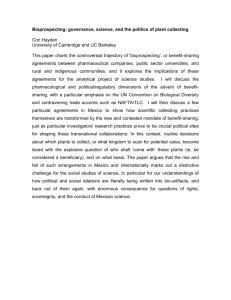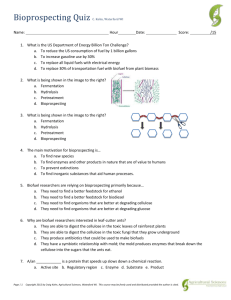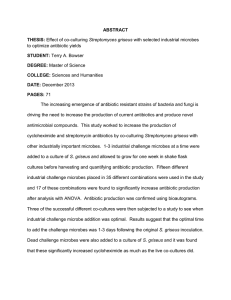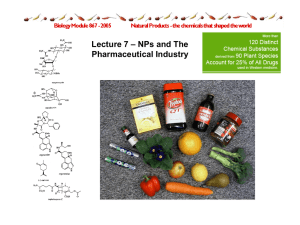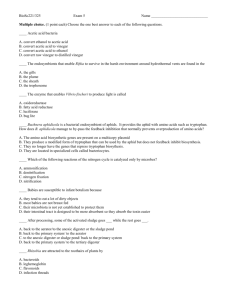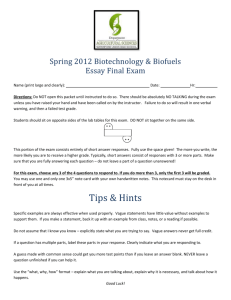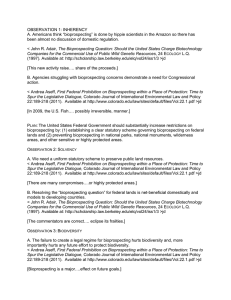Microbiology Test #2 Study Guide
advertisement
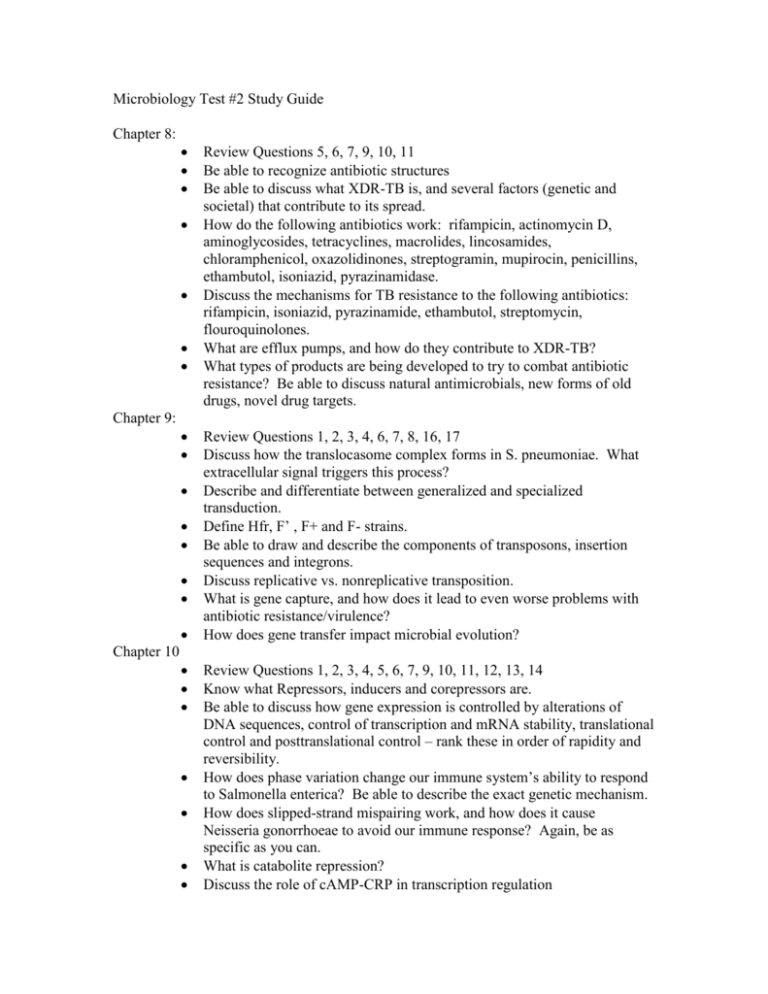
Microbiology Test #2 Study Guide Chapter 8: Review Questions 5, 6, 7, 9, 10, 11 Be able to recognize antibiotic structures Be able to discuss what XDR-TB is, and several factors (genetic and societal) that contribute to its spread. How do the following antibiotics work: rifampicin, actinomycin D, aminoglycosides, tetracyclines, macrolides, lincosamides, chloramphenicol, oxazolidinones, streptogramin, mupirocin, penicillins, ethambutol, isoniazid, pyrazinamidase. Discuss the mechanisms for TB resistance to the following antibiotics: rifampicin, isoniazid, pyrazinamide, ethambutol, streptomycin, flouroquinolones. What are efflux pumps, and how do they contribute to XDR-TB? What types of products are being developed to try to combat antibiotic resistance? Be able to discuss natural antimicrobials, new forms of old drugs, novel drug targets. Chapter 9: Review Questions 1, 2, 3, 4, 6, 7, 8, 16, 17 Discuss how the translocasome complex forms in S. pneumoniae. What extracellular signal triggers this process? Describe and differentiate between generalized and specialized transduction. Define Hfr, F’ , F+ and F- strains. Be able to draw and describe the components of transposons, insertion sequences and integrons. Discuss replicative vs. nonreplicative transposition. What is gene capture, and how does it lead to even worse problems with antibiotic resistance/virulence? How does gene transfer impact microbial evolution? Chapter 10 Review Questions 1, 2, 3, 4, 5, 6, 7, 9, 10, 11, 12, 13, 14 Know what Repressors, inducers and corepressors are. Be able to discuss how gene expression is controlled by alterations of DNA sequences, control of transcription and mRNA stability, translational control and posttranslational control – rank these in order of rapidity and reversibility. How does phase variation change our immune system’s ability to respond to Salmonella enterica? Be able to describe the exact genetic mechanism. How does slipped-strand mispairing work, and how does it cause Neisseria gonorrhoeae to avoid our immune response? Again, be as specific as you can. What is catabolite repression? Discuss the role of cAMP-CRP in transcription regulation Describe how AraC is regulated by the presence or absence of arabinose Describe how the trp operon is regulated by the presence or absence of tryptophan Describe how sigma factor H expression is regulated at 30°C and at 42°C. How does this sigma factor regulate heat shock responses? Discuss the roles and regulation of sigma factors during sporulation What is a regulon? Describe how one regulon regulates gene activity in response to iron levels. Describe how quorum sensing is involved in bioluminescence. Discuss several reasons why the ability to luminesce may be of evolutionary importance to microbes. Chapter 13 Review Questions 2, 4 Be able to define energy, entropy, fermentation, organic respiration, lihotrophy, anaerobic respiration, aerobic respiration How do molecular stability, entropy, concentrations, environmental factors determine the direction of a reaction? Discuss how communities can work together to make a reaction proceed that would not normally work for an individual microbe. Describe 3 ways in which ATP transfers its energy What is a terminal electron acceptor, and what determines how much energy is generated by electron transport? Chapter 16 What is bioprospecting? What are the pros and cons of bioprospecting? Why are extreme environments such good locations for bioprospecting? What types of products have been developed as a result of bioprospecting? Be able to give specific examples. What is an ‘ice minus’ bacterium, and how do bacteria help make snow? How do bacteria help make stone-washed genes? Describe three different ways in which algae make biodiesel. What are the pros and cons of each method? How do microbes contribute to the process of ethanol production for fuels? How do microbes make electricity? Give a specific example, and be able to discuss possible uses for the resulting energy. Be able to discuss what biopiracy is, and to discuss/evaluate the case study we looked at regarding stone-washed genes, Kenya and Genencor. What kinds of legislations are currently underway to prevent biopiracy? Counting Microbes: Be able to discuss the theory that lay behind your MPN experiments (that is, how did the media you used and the results you saw help you determine what types of bacteria you had) and to be able to calculate dilutions (like you did in the table for the lab….e.g. if you add 1 mL of bacteria to 9 mL of media, what is the dilution factor? How about if you add it to 3 mL?)

